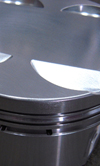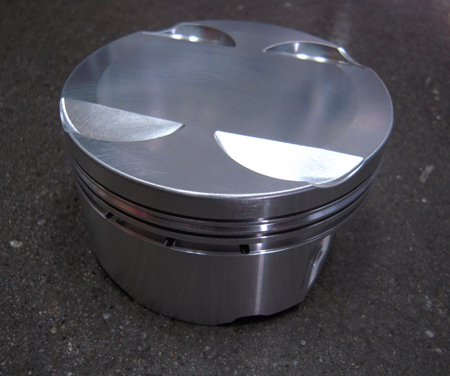Pistons that work
 When Rhys Millen Motorsports (RMR) decided to field a car in the 2010 Pikes Peak Hillclimb, it upgraded its Formula Drift engine to compete in the rarified air of the famous Colorado mountains and built an all-wheel-drive closed coupe, the RMR PM580, to contain it. The car and engine were completed in four months; there were only two tests before the climb.
When Rhys Millen Motorsports (RMR) decided to field a car in the 2010 Pikes Peak Hillclimb, it upgraded its Formula Drift engine to compete in the rarified air of the famous Colorado mountains and built an all-wheel-drive closed coupe, the RMR PM580, to contain it. The car and engine were completed in four months; there were only two tests before the climb.
Using Hyundai's Lambda 3.8 litre naturally aspirated V6, as found in the production Genesis coupe and sedan, Millen's team took the stroke out to 93 mm from 87 mm, raising the displacement to nearly 4.1 litres and using a single turbocharger.
Pistons for this engine come from a supplier local to Millen's shop, JE Pistons, in Huntington Beach, California. "They ask us what we're doing and what kind of displacement we're looking for, turbo or non-turbo applications and our combustion," says team manager Eric Cantore. "They look at all that and are able to come up with a great piston.
"We haven't seen any scoring on the skirts, the piston tops look great coming out," Cantore says. "Everything you might need for pushing nearly 700 horsepower and 700 lb-ft of torque, you need a piston that will keep everything cool."
Cantore and JE agreed on a three-ring piston of 331 grammes, a flat top with cuts in for the valves, to get a bit more lift out of them. "With our stroke being a bit higher now, we try to keep everything in the valvetrain as low as possible," says Cantore. "Instead of bringing the stroke down further, we brought it up a bit so we can keep the bottom end of the motor happy running the dry sump system."
The bespoke pistons are machined from 2618-T6 aluminium forging specific to the Hyundai Lambda V6's bore range and valve configuration, according to Sean Crawford at JE Pistons. The flat ring grouping and dish has a volume of -12.8 cc. The valve pockets have been enlarged and made deeper to provide necessary clearances, and the piston crown features a thermal barrier crown coating supplement. This coating, Crawford says, is up to 0.005 in thickness per surface and is designed to wear very slowly, even in the high-stress applications experienced at Pikes Peak and in Formula Drift.

After Pikes Peak, the team decided to continue with the 4.1 litre mill for its Formula Drift programme. "We kept the pistons in for five events after Pikes Peak and ran in a Brazilian race this December, as well," says Cantore. The latter event, on the Serra Do Rio Do Rasto in Santa Catarina mountain, encompassed a 156-turn course in 8 km, rather than Pikes Peak's same number of turns in 12.42 miles!
"Even though we don't do a lot of mileage at our races, we do a lot of testing before and after each event, and do events like the one in Brazil and fun runs for Hyundai," says Cantore. "The engine does get quite a bit of mileage - on an average weekend you're looking at maybe 100 miles.
"We look at our pistons after each race but we don't do a complete teardown until we see something. We'll look inside to see if there are any issues, any unexpected wear. We did a leakdown and compression check before leaving for Brazil and the engine was still showing great numbers. The pistons were so good we just left them in."
While RMR doesn't have a mileage stipulation for its pistons, Cantore says, "We are keeping note on it. The pistons haven't had to be changed because of wear yet, but we'll likely swap them out before starting the new year of seven Formula Drift events."
While the Hyundai engine doesn't go long distances on a race weekend, he says, "We do get temperature real fast, run real hard and then stop. As little as it does run, the engine does have very high rpm - and with Pikes Peak you've got the altitude to deal with and the heat changes."
Practice for Pikes Peak starts at 5am and finishes around 9am. The race, on the other hand, can start as late as noon. "So the race temps have nothing to do with the practice times," says Cantore. "In practice, the ambient temps may be 50-60 degrees and then, at start line you're at 80 degrees, so you have to take that into consideration." As it was, the engine posed no problems for Rhys' (Millen) climb, but other factors relegated him to a third-place finish in the Unlimited class.
Fig. 1 - This triple-ring, flat-top JE Piston is made from 2618-T6 with enlarged valve pockets (Photo: Anne Proffit)
Written by Anne Proffit